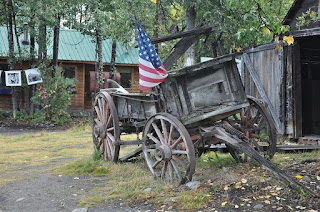Little Detective on the Prairie
Warning. If you are a devoted fan of:
2.
The
TV series “Little House on the Prairie”
3.
Slavish
devotion to the infallibility of the authorial voice even in the face of evidence
to the contrary
I remember the first time I came across Laura Ingalls Wilder. I was seven years old, a seasoned reader and one of the leaders at Girls’ Brigade offered me a slightly tattered book with a picture of a little girl and her mother standing by a bear on the front. I took it home and devoured it. And so began my love affair with America’s best known pioneering family.
Everyone knows Laura. She lives with her
Ma and Pa and three sisters and their journeys across America in the late
nineteenth century in a covered wagon are testament to their grit,
determination and strong family values. As a child, I read them and loved them.
Ma mistaking a bear for the family cow, Pa playing his fiddle under the stars,
the little sod house on Plum Creek, mean old Nellie Olsen, Mary going blind,
young Mr Wilder, the happily ever after with the perfectly matched Morgan
horses and the prairie roses …… it’s a wonderful slice of Americana.
I’ve just finished, “Prairie Fires: The
American Dreams of Laura Ingalls Wilder” by Caroline Fraser. An excellent, well-balanced
read, it draws on a wide range of sources and gives a clear, fascinating picture
of the family and their times. Like many others, the author concludes that
Ingalls painted a deliberately careful portrait of a united, loving, self-sufficient
family but left out a number of facts from their lives. Caroline Ingalls was
not as meek and long-suffering as she is sometimes made out to be, Charles Ingalls
once skipped town owing money and rather than forging ahead from Wisconsin to Dakota
Territory, the Ingalls went back and forth cross-country as many pioneering
families did.
But it’s the deaths of three baby boys across three generations that I want to know about. Caroline and Charles had a son called Frederick who died at eight months old. Laura’s second child, a boy, died at four weeks. Rose lost her baby boy when she was six months pregnant. Caroline’s family, the Quiners, intermarried with the Ingalls three times and the other couples had large families of both boys and girls. What was going on in this particular family tree?
I started looking for clues.
Laura was tiny, under five feet tall. Her adolescence was characterised by stress and malnutrition (seven months living on coarse brown bread, water and turnips when she was fifteen during the Long Winter) and I would have expected her to have relatively small babies. But we’re told Rose was eight pounds and that the unnamed Wilder son was ten pounds. Laura’s sister Mary went blind. Was it scarlet fever? Meningitis? No-one seems to know. Mary never married or had children. Carrie, the third daughter, married but was childless, as was Grace, the youngest. In a time when contraception was not common, why were these young women not getting pregnant or at least giving birth to live babies?
I found the clues in, “Prairie Fires”. Caroline Ingalls died of complications of diabetes as did her daughter Grace. Loss of sight is one of the side-effects of the untreated condition, which might explain Mary’s blindness. Diabetic women often give birth to very large babies (nowadays, scans and blood tests generally spot this during pregnancy). Pre-eclampsia is a very serious related condition which can also lead to premature birth. Birth defects, both ante- and post-natal are far more common in babies born to undiagnosed diabetic mothers.
Shortly before her death, Laura was diagnosed with diabetes. It seems to have been a condition which ran through the family, possibly coming from the Quiner line. Could this be the reason that she, her mother and her daughter were never able to see a son live past the age of eight months?
I can never unread, “Prairie Fires” nor forget that Pa, Almanzo and all the other settlers ploughing up the prairies directly contributed to the catastrophic climate change which brought about the Dust Bowl of the 1930s and led to so much misery and loss. The way that characters in the books speak about Native Americans is also hard to read as an adult.
I am not a fan of the TV series at all (I think I’ve sat through about two episodes). The amount of saccharine sprinkled on already fairly sanitised books and the fact that Pa takes his shirt off to split logs or do outside work at least twice an episode, has no beard, appears to condition and blow dry his hair and has a healthy son named Albert (huh?) is more than I can take.
Too much sugar.
It puts a completely different spin on all
that Christmas candy and the sugaring dance at Grandma’s. I read the Little
House books very differently now, as an adult, than I did as a child and teenager,
but they still contain beautiful, lyrical writing and describe a life long
since gone by in a completely unique way. My teenage sons are reading them,
charmed by the descriptions and the history. But of course, as we all know,
nothing is ever quite as it seems.
Images by Pixabay and author's own



Comments
Great to hear your teenage sons are reading them. Would they like Katy or Anne do you think?
I suggested the books to help the middle son with his GCSE History and he really took to it. I don't know if they would like Katy or Anne so much as that's fiction. They are more factual chaps.